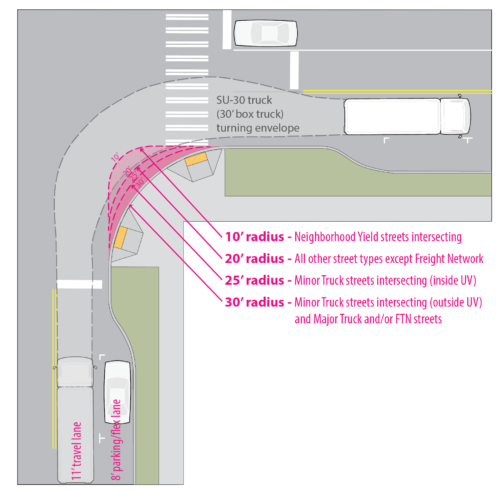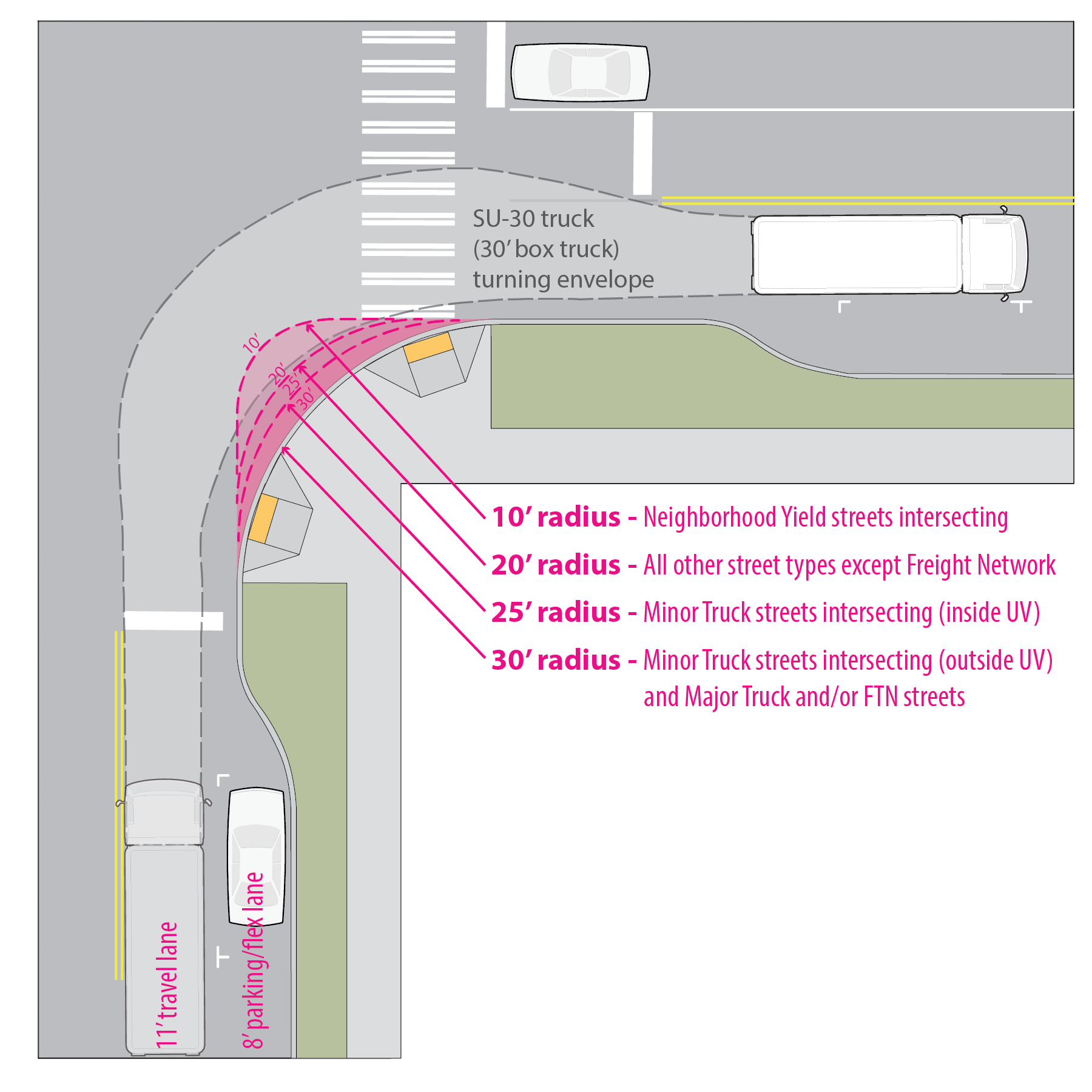3.9 Intersections
- Design Standards
- Design Guidance
On this page:

The goal of intersection design is to improve safety to the greatest extent possible, while accommodating safer and efficient access for all travelers that pass through and make turning movements at intersections. SDOT’s policy is to reduce pedestrian crossing distance and reduce the speed of turning vehicles by incorporating the smallest possible curb radius, while accommodating the standard design vehicle (in most cases, an SU-30 with a 42’ turning radius).
Design Standards

Design vehicle: SDOT’s standard design vehicle is SU-30 with a 42 foot turning radius. Designers should use this vehicle when using Auto Turn for intersection analysis. On Industrial Access streets, Urban Center Connector streets, major and minor truck streets or other locations where SDOT would anticipate a larger vehicle using a site, a radius evaluation based on a larger vehicle would be required. Examples of typical turning templates would include a WB-40, WB-50, or in rare instances, particularly on Industrial Access streets, a WB-67 (AASHTO Policy on Geometric Design); however, this list is not exhaustive and designers should be prepared to work with other templates that may be provided by the City of Seattle or other sources such as transit agencies. Designers should be prepared to submit supporting documentation, including detailed Auto Turn or equivalent turning analyses, as requested by the City Traffic Engineer in support of their evaluation of specific corner designs. The City’s evaluation will include consideration of strategies for minimizing curb radii described below.
Minimizing curb radius: The default curb radius for two intersecting Neighborhood Streets is 10 feet (exceptions apply for angled streets where it is not possible to achieve a 10 feet radius, or where particular traffic calming devices exist). For all other street types (except Urban Center Connector Streets and Industrial Access streets that have been designated as part of the Freight Network) including streets that intersect with Neighborhood Streets, corner design should strive for an actual curb radius that is no more than 20 feet. A variety of strategies can be employed to minimize the actual curb radius:
- On low volume two-lane streets, corner design should assume that a large vehicle will use the entire width of the departing and receiving travel lanes, including the oncoming traffic lane.
- At signalized intersections, corner design should assume the large vehicle will use the entire width of the receiving lanes on the intersecting street.
- At signalized intersections where additional space is needed to accommodate turning vehicles, consideration can be given to recessing the stop line on the receiving street to enable the vehicle to use a portion of or the entire width of the receiving roadway (encroaching on the opposing travel lane). Recessing the stop bar should be balanced with signal operations.
- In some cases where there are alternative access routes, it may be possible to restrict turning movements by large vehicles at certain intersections and driveways to enable tighter curb radii. Turn restrictions and alternate access routes must be properly signed and must be approved by SDOT.
Curb radius: The table below lists the standard curb radius per street type. However, deviations from these standards can be requested and will be considered on a case-by-case basis. Examples of anticipated requests include when land use context requires larger vehicle movements (large grocery stores), or existing traffic calming devices are present.
| Street Intersections | Curb radius |
| Neighborhood Yield Streets Intersecting | 10 feet |
| All other Street Types, except Freight network | 20 feet |
| Minor – Minor Truck Streets Intersecting | 25 feet |
| Major – Minor Truck Streets Intersecting inside an Urban Village | 25 feet |
| Major – Minor Truck Streets Intersecting outside of an Urban Village | 30 feet |
| Major – Major Truck and or FTN Streets | 30 feet |
See the Clearances section for standards for intersection clearances.
Design Guidance
Intersection design, and more specifically the design of street corners, requires a great deal of design flexibility and engineering judgment. Each intersection is unique in terms of the angles of the approach and departure, the number of travel lanes, the presence of a median, and a number of other features that fundamentally impact corner design.
Generally, the design of intersections should be driven primarily by factors that maximize the safety of the intersection: minimizing the number of conflict points, reducing the number of legs of multi-leg intersections where feasible, and providing perpendicular crossing alignments where feasible, and reducing driveway access points within the functional area of a signalized intersection. Lane offsets through the intersection should be minimized to the extent feasible; where lane offsets exceed 3 feet of lateral offset through the intersection, or where multiple lanes are offset in parallel, supplemental markings directing traffic to the appropriate downstream receiving lane through the intersection should be considered.
Corner design should take into account the effective curb radius (the curve which vehicles follow when turning, which may be affected by on-street parking, bicycle lanes, medians, and other roadway features) in addition to the actual curb radii, which can often be smaller.
While pedestrian safety is negatively impacted by wide crossings, pedestrians are also placed at risk if the actual curb radius is too small and trucks wheels come up on the curb. Maintenance problems are also caused when trucks must regularly drive over street corners to make turns.
As described elsewhere in these guidelines, curb bulbs are beneficial to pedestrians. It is acceptable to have a curb bulb with a larger curb radius that shortens crossing distances while accommodating large vehicles.
For curbless streets, care must be taken at corners to ensure that proper design treatments are included to identify safer turning distances for large vehicles. Such treatments may include pavement coloring, different materials, and other features that provide a visual indication of the apex of the turn.


